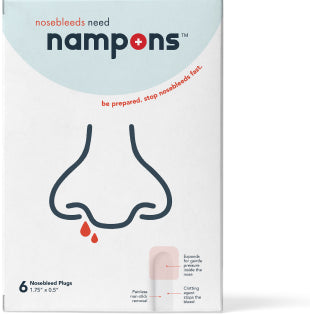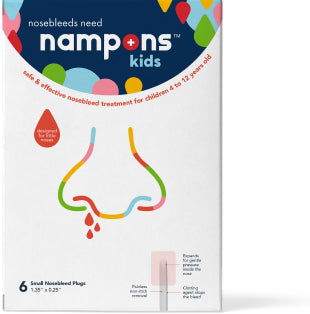This article was guest written by Dr. RP Lindeman, who received a BA from Yale and an MD-PhD from Columbia. He was trained in general pediatrics and pediatric pulmonary medicine at Boston Children’s Hospital. He practiced pediatrics in Massachusetts for over 20 years.
Back to School—How to Handle Nosebleeds at School
Nosebleeds can be a common occurrence for younger children and can be particularly concerning at school. While most nosebleeds are harmless and can be managed easily, parents, teachers, and caregivers need to understand why they occur, what to do should the child experience one, when medical attention is necessary, and how to prepare them if it happens again.
Why do Children Get Nosebleeds in School?
Nosebleeds in children often result from the delicate blood vessels in the nose becoming irritated and rupturing. Nosebleeds are more common in younger than older students (although upper-level students get nosebleeds too!) Adults get nosebleeds, as we all know, but children get them more often, even in school. This happens for several reasons.
Picky Picky!
First, children tend to pick their noses more than we do (notice I said, ‘more than we do’. I know some readers do it!) They do this because their noses may itch or be irritated. Many kids pick their noses out of habit. These are the patients of mine whose noses bleed most often: they may have scabs that form over the places inside their noses that bled the other day. Then the scab becomes itchy, the child picks their nose again, and the cycle repeats.
Dry Air
Newer school buildings tend to be dryer than the schools we grew up in. Schools in dryer climates are even more likely to give rise to students with nosebleeds. Schools in cold latitudes (even in New Jersey, where I attended school) tend to give the students dry nasal passages; the dry, hot air makes blood vessels in the nose more susceptible to breaking.
Allergic to School?
It is not just an expression. Some children genuinely are allergic to school! By this, I mean they are allergic to products used in their school (e.g., chalk dust, dry-erase markers, and cleaning products). Allergic reactions can cause inflammation in the nasal passages, increasing the likelihood of nosebleeds.
Colds and Infections
Kids get sick in school; it is a fact of life. Viral infections, or colds, can irritate and inflame the nasal lining, leading to nosebleeds.
Dr. Lindeman’s Favorite: Foreign Bodies in the Nose
Younger schoolchildren put things in their noses. It is a natural form of exploration, but it often does not end well. Sometimes, the so-called ‘foreign’ object’ can injure the delicate membranes and cause bleeding.
Accidents Will Happen
I tell parents in my practice that if their child has not been hit in the nose by a dodgeball or a tetherball, it means they have not been playing dodgeball or tetherball! Getting bonked in the nose is a natural part of physical activity. Lunchtime on the playground is a typical time that these accidents happen. My children’s schoolmates invented a game that involved throwing a tennis ball against the wall as hard as they could (this game had rules, though I confess I never figured them out!) Nosebleeds were side-effects of the wall-ball game.
What Should Children Do When They Get a Nosebleed at School?
If a younger child experiences a nosebleed at school, it is essential to teach them the following steps to manage the situation calmly and effectively. Teachers are usually well-trained in these steps.
Stay Calm
Encourage the child to remain calm to avoid panic and further agitation.
Sit Up!
Instruct the child to sit upright and lean slightly forward to prevent swallowing blood, which can make them nauseous.
Use Nampons!
Depending on your school district, the child may be allowed to carry Nampons with them, or they may need to be stored in the classroom or nurse’s office.
Pinch the Nose
If Nampons are unavailable, have the child pinch the soft, fleshy part of the nose below the bridge and hold it firmly for about 10–15 minutes. It is not necessary to apply ice. This might only result in the child getting ‘brain freeze’ as you might from eating ice cream, but it is not likely to help much with the nosebleed.
Breathe Through the Mouth
Remind the child to breathe through their mouth while holding the nose to ensure proper airflow.
Avoid Tilting the Head Back
Contrary to popular belief, tilting the head back during a nosebleed is not a good idea. Elementary school teachers generally know that you should not do this. It can cause blood to flow down the throat and lead to choking.
When Should Children See a Doctor?
While most nosebleeds are minor and resolve independently, certain situations warrant medical attention. Advise parents and teachers that the child must be taken to the doctor in the following cases.
- If the child experiences nosebleeds more than once a week, it could indicate an underlying issue that requires evaluation. Remember that the problem might be the school itself!
- If the bleeding lasts more than 20 minutes despite applying pressure as above, it is best to seek medical help.
- If the child loses significant blood or feels weak and dizzy, immediate medical attention is necessary. This symptom is very rare and might only occur if the child suffered a significant blow to the face. In any case, it is a symptom that should be taken seriously.
- If there's a family history of bleeding disorders, it is essential to consult a doctor for proper evaluation.
How Should Children Be Prepared If Nosebleeds Have Happened Before?
Talk About It! Have an open conversation with the child about nosebleeds, explaining that they are usually not severe and can be managed with simple steps.
Teach Proper Nose-Blowing. Instruct the child to blow their nose gently to avoid excessive irritation of the nasal passages.
Stay Hydrated. For several reasons, Some children do not drink at all during school. Encourage the child to stay hydrated as it helps prevent the nasal lining from drying out.
Avoid Nose Picking. Remind the child not to pick their nose, which can lead to injuries and nosebleeds.
Have a Supply Kit. Consider putting together a small nosebleed supply kit for the child to keep in their school bag. Include Nampons, a small towel, or a water bottle to wash hands and clean up.



